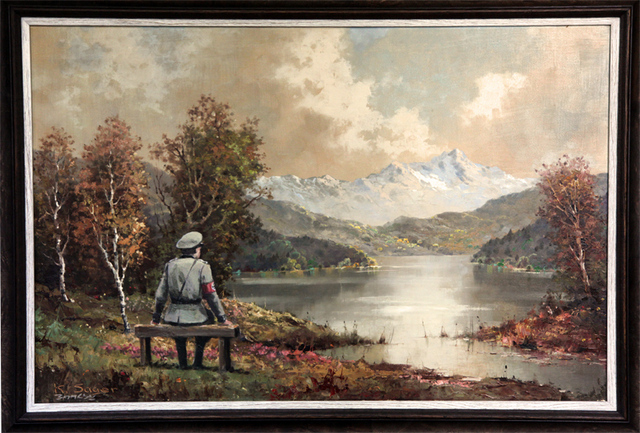Photo: Dennis Kardon © 2014
There’s much that disturbs me about
Kara Walker’s
much-lauded
and wildly popular
installation
at Brooklyn’s defunct Domino Sugar refinery, but I’ll start with its undeniable
beauty. Made of sparkling white sugar, this gigantic, crouching sphinx-like figure,
with curves like a
Brancusi,
looms like a symbol of purity in the vast darkness and decay of the factory’s
interior. The sweet smell is overwhelming, and the piece itself is intended to
degrade over time; when I was there, skeletal dark lines were beginning to form
between the polystyrene blocks that form the core of the sculpture.
Conceptually and figuratively, it’s a virtuoso performance that brilliantly
fulfills part of nonprofit
Creative Time’s
original mission to ”
support
the creation of innovative, site-specific, socially engaged works in the public
realm, especially in vacant spaces of historical and architectural interest…while
pushing artists beyond their normal boundaries.” [See note below]
So why
does its beauty upset me? Because the installations’ sheer gorgeousness and
spectacle serve as a distraction from the insidious agenda that makes a mockery
of another part of Creative Time’s mission, to “foster social progress.” I have long felt that Walker’s work—in which Black people are portrayed as passive victims of slavery engaged in psycho-sexual drama—doesn’t invalidate, but rather
reinforces the stereotypes whites have imposed on them to justify racism. In addition, it is entirely dependent on the gratuitous titillation that violence and sex
inevitably engender, regardless of the context—or the race of the person who
perpetrates them. Walker’s sphinx conflates two familiar white parodies of Black women: the big-assed, sexually available Jezebel, with her vulva hanging out for the taking,
and her opposite, the maternal, large-breasted but desexualized Mammy, who sublimates her own needs to fulfill those
of her white charges.
Vulgar
photos taken by visitors posing with the “sphinx” are all over Instagram, and castigated online by writers who are upset that the artwork is not being shown
proper respect. Derived from minstrel
shows where
whites in blackface lampooned Black people, the Jim Crow caricatures Walker appropriates were
created with the specific intention of provoking ridicule. Should we then be
surprised when they succeed?
Roberta
Smith in the
Times writes that Walker “
evokes the history of the
sugar trade, its dependence on slavery and slavery’s particular degradation of
women, while also illuminating the plagues of obesity and diabetes that keep so
many American dreams unfulfilled.” Yet it can also be said that Walker is
providing massive advertising for
Domino Sugar,
which donated the 80 tons that make up the sculpture. As a sponsor, the
familiar Domino logo is prominently featured on a wall at the site as well as
Creative Time’s
website,
and a Google search for ‘“Kara Walker” Domino’ garners over 88,000 links. Statements
that speak of “history,” along with the fact that Walker’s images are based nostalgically
on our antebellum past, present a view of slavery that locates it dangerously
outside the present capitalist global economy—when it is still very much part
of it.
While Creative Time’s website includes a
compelling
essay written by the narrator of a
documentary
about the forced and child labor that constitute modern slavery, it doesn’t
name the mega-corporation that owns Central Romano, the plantation on which it was filmed: Flo-Sun,
of which Domino is its best-known subsidiary. If the people at Creative Time,
along with Walker, have seen this film—as indeed they must have in their
research—I wonder how they feel about the ironic possibility that Walker’s
sculpture might have been enabled by slave labor.
Pepe
and Alfy Fanjul, who run Flo-Sun, inherited the sugar empire from their
Cuban father.
Dubbed
“the Koch brothers of Southern Florida,” they‘re said to be friends and
neighbors of the
Kochs
who, in comparison with the sugar barons, look like Mother Theresa clones.
In the Dominican Republic, the
Fanjuls have been subject to repeated allegations of labor exploitation,
particularly of undocumented Haitian migrant workers with little to no legal
standing before Dominican government institutions. The U.S. Department of
Labor includes sugar from the Dominican Republic—much of which comes from
Fanjul-owned plantations or is imported to Fanjul-owned refineries—on its
annual "List of Goods Produced by Child or Forced Labor."
Both a 2005 Canadian Broadcasting
Company documentary [“The Price of
Sugar,” narrated by Paul Newman, view here]
and the 2007 film "The Sugar
Babies," narrated
by Haitian writer Edwidge Danticat [author of the Creative Time essay] call attention to the working
conditions of impoverished cane-cutters laboring at the Fanjuls' Central Romana.
In the United States, meanwhile, opponents of U.S. agricultural
subsidies and government protections have long
criticized the Fanjuls for building their dominance in the domestic market on
the backs of artificially inflated prices and the U.S. taxpayer…. more
Essential
reading includes the 2001 Vanity
Fair article, “In the Kingdom of Big Sugar,” which inspired the
two documentaries, a CNN piece on how the Fanjuls
could be the “First Family of Corporate Welfare,” and this on their strong-arm
tactics with lawmakers, from Wikileaks.
You
could spend days, as I did, reading about the moral and ethical transgressions of
the Fanjuls, and just when you think it couldn’t get worse, it does: In 2010,
the Post’s Page
Six reported
that Pepe Fanjul’s executive assistant of 35 years is the ex-wife of former KKK
leader David Duke, and the current wife of Don Black, a former KKK grand wizard and member of the American
Nazi Party. He now runs white-supremacist website StormFront.org. A company representative
said, “While we may not agree with someone’s politics, we wouldn’t terminate
them for that….We will not discriminate against anybody….”
One
could also make an issue of the extensive advertising Walker is providing for
another sponsor, Two Trees Management, owned by Creative
Time board member Jed Walentas, who worked for Trump before taking over
his father’s real estate business, and will have 1700 luxury apartments to sell
in his massive waterfront development on the site (as well as 700 affordable
units, the number bumped up under pressure from Mayor de Blasio). And then
there’s the non-renewable polystyrene that went into this gigantic
temporary work that, like Styrofoam, could take a million years to break down. However
next to the question of how the 80 tons of Fanjul sugar were most likely sourced,
these are mere quibbles.
So
much for institutionalized protest—to paraphrase Banksy, this is art packaged to look like
radicalism while supporting capitalism at its worst.
Photo: Carol Diehl (2014)
***








